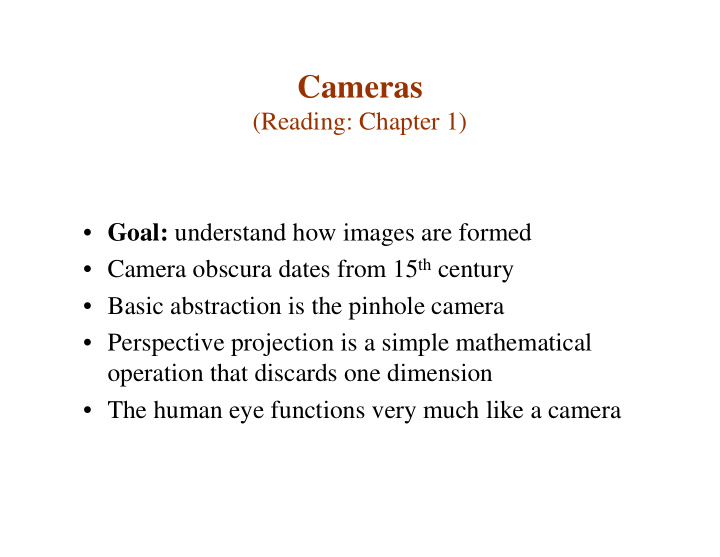



Cameras (Reading: Chapter 1) • Goal: understand how images are formed • Camera obscura dates from 15 th century • Basic abstraction is the pinhole camera • Perspective projection is a simple mathematical operation that discards one dimension • The human eye functions very much like a camera
Camera Obscura "When images of illuminated objects ... penetrate through a small hole into a very dark room ... you will see [on the opposite wall] these objects in their proper form and color, reduced in size ... in a reversed position, owing to the intersection of the rays". Da Vinci http://www.acmi.net.au/AIC/CAMERA_OBSCURA.html (Russell Naughton) Slide credit: David Jacobs
Jetty at Margate England, 1898. http://brightbytes.com/cosite/collection2.html (Jack and Beverly Wilgus) Slide credit: David Jacobs
First known photograph
Pinhole cameras • Pinhole camera - box with a small hole in it • Image is upside down, but not mirrored left-to-right • Question: Why does a mirror reverse left-to-right but not top-to-bottom?
Pinhole camera in 2D X’ = (f’ / Z) X
Pinhole camera in 2D (with reflected image plane) The image is the same after reflection of the image plane, except that image is the right way up!
Distant objects are smaller Size is inversely proportional to distance.
Parallel lines meet Example of the film plane drawn in front of the focal point. Moving the film plane merely scales the image.
Vanishing points • each set of parallel lines • Good ways to spot faked meets at a different point images – The vanishing point for this – scale and perspective don’t direction work – vanishing points behave • Sets of parallel lines on badly the same plane lead to collinear vanishing points. – The line is called the horizon for that plane
Slide credit: David Jacobs
Properties of perspective projection • Points project to points • Lines project to lines • Planes project to the whole or half image • Angles are not preserved • Degenerate cases – Line through focal point projects to a point. – Plane through focal point projects to line
The equation of perspective projection
Weak perspective Assume object points are all at same depth -z 0
Orthographic projection
Pros and Cons of These Models • Weak perspective (including orthographic) has simpler mathematics – Accurate when object is small relative to its distance. – Most useful for recognition. • Perspective is much more accurate for scenes. – Used in structure from motion. • When accuracy really matters, we must model the real camera – Use perspective projection with other calibration parameters (e.g., radial lens distortion)
Why not use pinhole cameras? If pinhole is too big - many directions are averaged, blurring the image Pinhole too small- diffraction effects blur the image Generally, pinhole cameras are dark , because a very small set of rays from a particular point hits the screen.
The reason for lenses
Snell’s law n 1 and n 2 are the indices of refraction of each material
Pinhole model with a single lens A lens follows the pinhole model for objects that are in focus.
An out-of-focus lens An image plane at the wrong distance means that rays from different parts of the lens create a blurred region (the “point spread function”).
Spherical aberration Historically, spherical lenses were the only easy shape to manufacture, but are not correct for perfect focus.
Lens systems • A good camera lens may contain 15 elements and cost a thousand dollars • The best modern lenses may contain aspherical elements
Vignetting • Human vision is quite insensitive to slow change in brightness. • However, computer vision systems may be affected.
Other (possibly annoying) phenomena • Chromatic aberration – Light at different wavelengths follows different paths; hence, some wavelengths are defocussed • Scattering at the lens surface – Some light entering the lens system is reflected off each surface it encounters (Fresnel’s law gives details) – Cameras: coat the lens, interior – Human vision: lives with it (various scattering phenomena are visible in the human eye) • Geometric phenomena (radial distortion, etc.)
Human Eye • The eye has an iris like a camera • Focusing is done by changing shape of lens • Retina contains cones (mostly used) and rods (for low light) • The fovea is small region of high resolution containing mostly cones • Optic nerve: 1 million flexible fibres http://www.cas.vanderbilt.edu/bsci111b/eye/human-eye.jpg Slide credit: David Jacobs
CCD Cameras http://huizen.ddsw.nl/bewoners/maan/imaging/camera/ccd1.gif Slide credit: David Jacobs
Recommend
More recommend